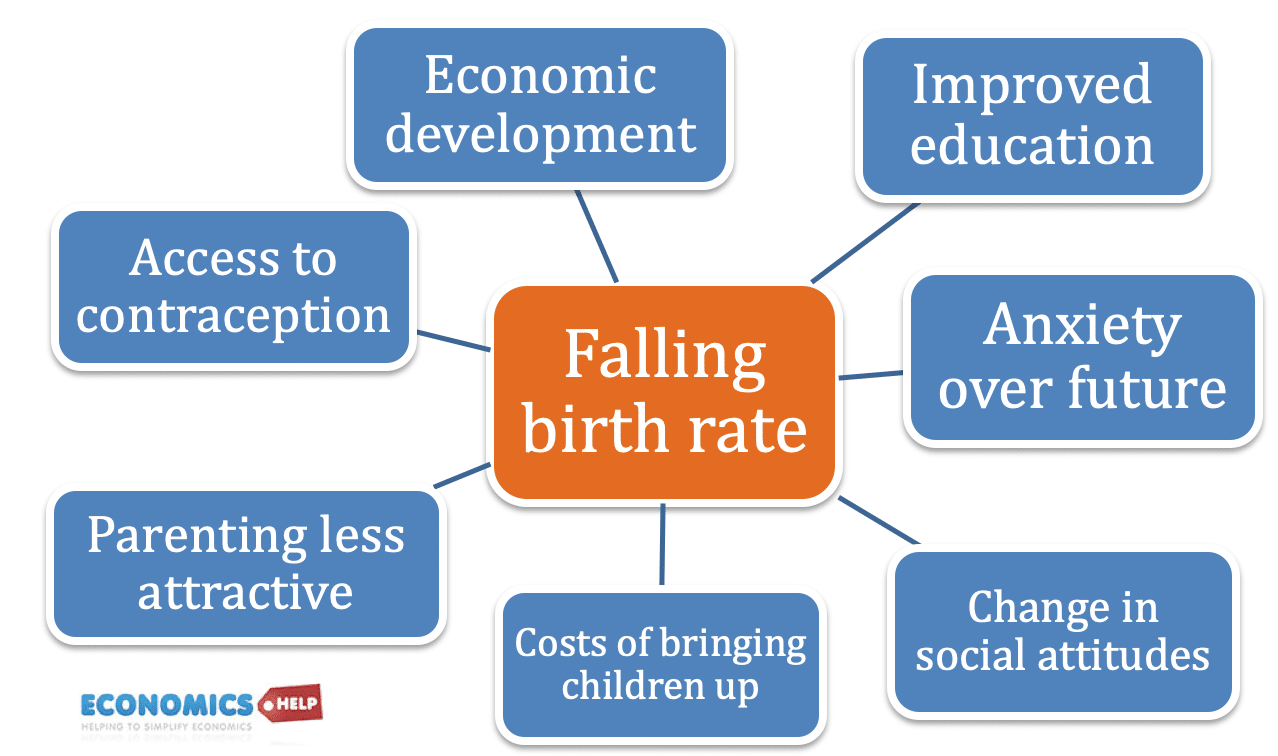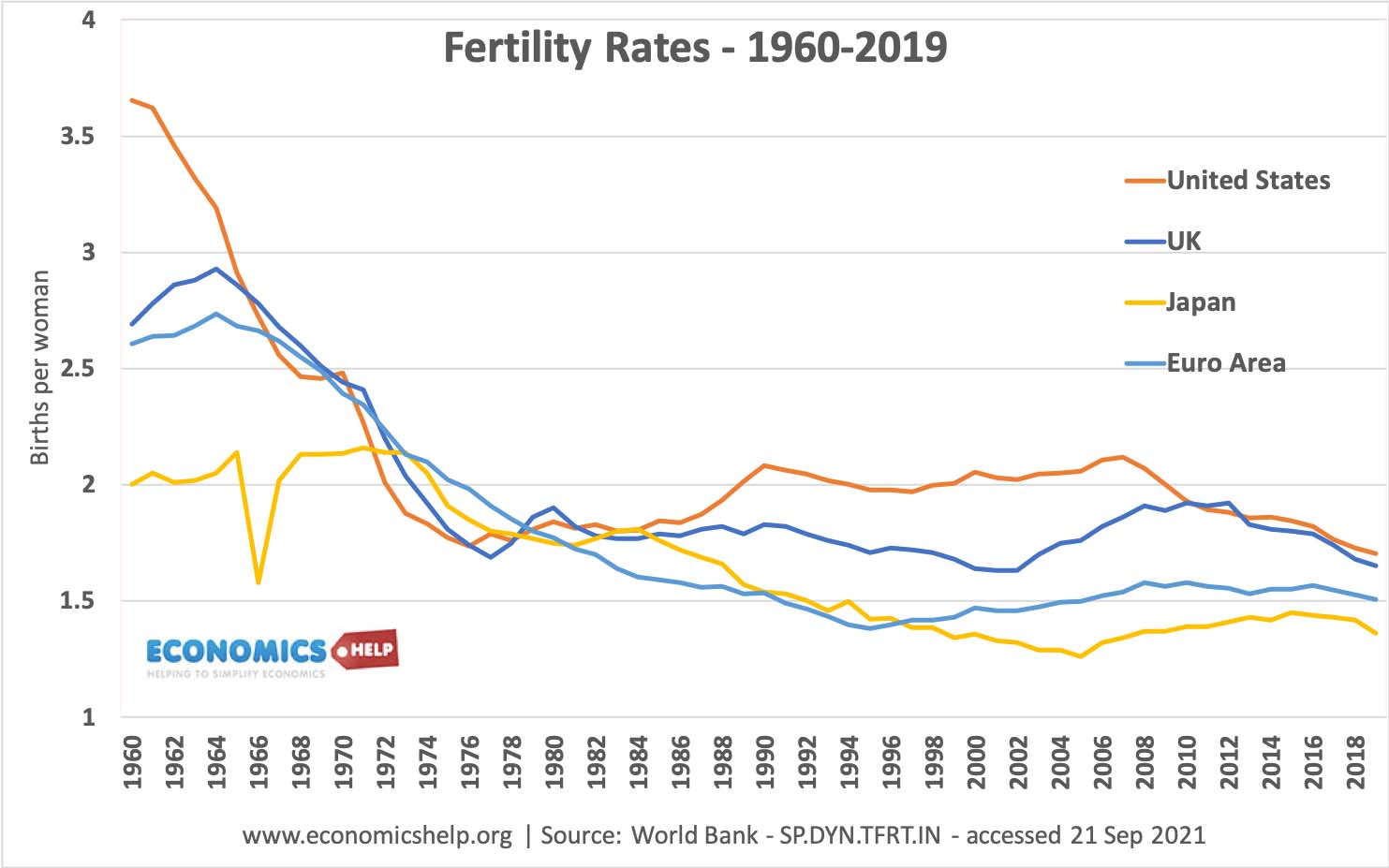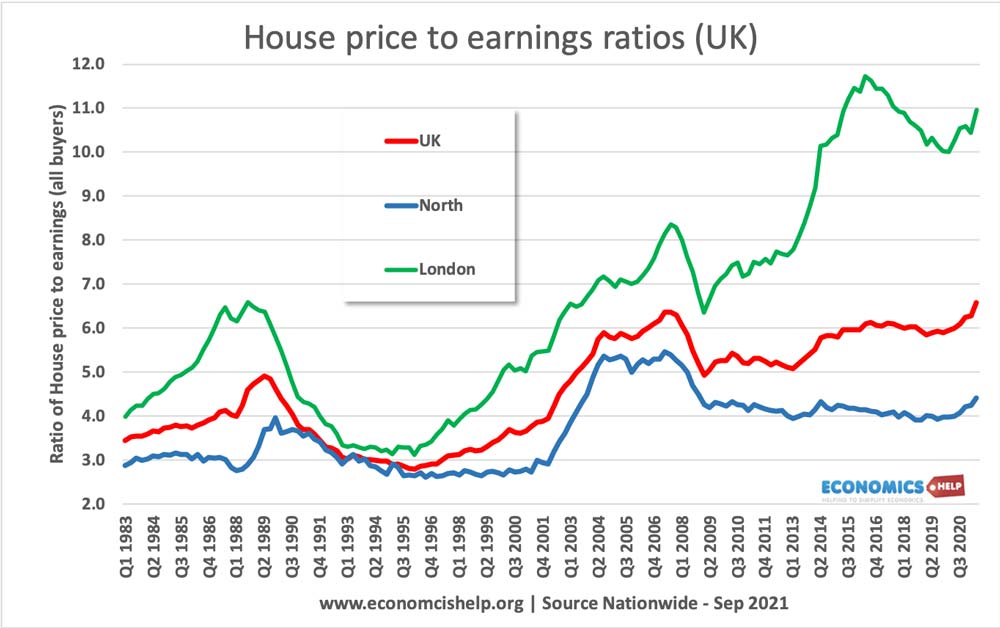Across the globe we are seeing a dramatic fall in the birth rate, with countries like Italy forecast to see their population decline from 61 million to 28 million by 2100. There are several reasons for falling birth rates – traditional factors include economic growth, improved education and access to contraception. But, in recent years, a second wave of factors has pushed the birth rate even lower. These include – anxiety over the future, Covid, the high cost of living in the west and changing social norms. These changing social norms include decline in marriage, more people remaining single and young people prioritising work over parenting. Whilst financial incentives might tackle some of the economic reasons, it is much harder to tackle the underlying change in social attitudes to having children.
Video summary
More details on reasons for a falling birth rate
Economics. At low levels of income and limited economic development, children can be an economic asset to their parents. From an early age, young children can help their parents work the land and bring in food and income for the family. Also, having many children can act as a form of pension. In societies without social welfare and pensions, having several children is the best insurance policy that someone will be able to look after you, if you become unable to work in the future. However, once, society provides education and pensions, this changes. Far from being an economic asset, a child who attends several years of school becomes an economic burden. A child going to school has costs (food, travel, clothing) but does not help work for the family. Also, when a society is able to provide pensions, there is no longer the need to have several children to act as informal pension. Therefore, as developing countries make a switch from subsistence farming (where children work on the farm) to a society with schooling and some pension provision, we can expect a very rapid fall in the birth rate.
Education. There is a strong link between education and birth rates. As education improves, women have more opportunities and are keener to pursue a career, which usually involves delaying having children. Max Rose, an Oxford economists states. “The level of education in a society – of women in particular – is one of the most important predictors for the number of children families have,”
In particular, better education usually leads to better access and understanding of contraception. Access to reproductive health services is a big driver of falling birth rates. A 2010 study, found the contraceptive pill was responsible for 40% of the fall in fertility rates in US since the 1960s. (link)
Why having fewer children maximises utility
In 1960, the economist Gary Becker wrote an influential paper seeking to explain birth rates from an economic perspective. He argued birth rates were influenced by usual economic concepts of the utility and cost of children to parents. In particular, he observed a quantity versus quality tradeoff in fertility choice. For example, if a family have just one child, then they can afford to hire private tutors and get the best education and opportunities for that child. (Quality of the child is high) However, if a modest family were to have three of four children, their resources would be spread more thinly and they wouldn’t be able to afford private education, holidays e.t.c. So the “quality” of the child would decline. This can explain why despite rising incomes, many parents were wanting to have low numbers of children to give them the best possible start.
Second Demographic transition
Away from economics, there have been huge shifts in attitudes towards life. There has been a decline in religious attendance which has often placed great value on ‘family life’ Instead young people feel their sense of self can be complete without children. They may be fully committed to work or a career and feel that is more rewarding than giving up chance for promotion to have a child. Even the nature of relationships has changed, with big falls in marriage and more people remaining single. Lesthaeghe and van de Kaa (1986) and Lesthaeghe (2014) have proposed a “second demographic transition” This emphasises not education and income but a shift of individual autonomy and de-emphasis of marriage and parenthood. Zaidi and Morgan (2017) have stated “tastes and preferences have irreversibly changed” In other words, having children is just not seen as desirable as it used to be – regardless of economic factors.
Lack of affordability
In the west, having children has become increasingly expensive, especially in cities where the cost of living has grown rapidly. In the US and Europe (especially in major capitals) the supply of housing is limited. This has pushed prices of property well above inflation and in many cases earnings. With very high costs of living, an extra child (and the need to buy or rent a bigger house) becomes very expensive. One 2015 estimate of the cost of raising a child to the age of 17 is $233,610 (link) Just as important as the actual cost of children is the expected loss of earnings to women who take time off from work.
London is typical of how house prices to rents have grown rapidly. With young people struggling to rent a place of their own, having children to house, feed and cloth is an additional expense they may not want.
In a 2018 survey conducted for the New York Times, the leading self-reported reasons for why US adults had fewer children than they planned included concerns about the expense of childcare costs, the costs of raising a child, and worries about the economy or their own financial instability (Miller 2018).
Fertility gap
The fertility gap is the difference between the number of children, people would like and the number of children they actually have. In the west, the fertility gap is small but significant. If young people could have as many children as they want (afford) then the fertility rate would be marginally above 2. Many parents who would like a 2nd or 3rd child are put off by the costs of bringing another child into the family.
Fertility trap
Western society has an ageing population. This means there is a shrinking number of young people who are potential parents. Therefore the current low fertility tends to lead to lower fertility in the future. The ageing population also puts pressure on government spending requiring more health care and pensions. This makes it harder for the government to give tax breaks to young people, who instead, face the prospect of higher tax burdens to deal with the ageing population
Uncertainty
In research, “uncertainty” is often given as a major factor in not having children. This can be economic uncertainty (unemployment, temporary contracts, difficulty getting housing) but also wider uncertainty such as the impact of global warming and the impact of Covid.
Social expectations
A key determinant of birth rates is social expectations of the average family size. When the average number of children in a society is high, then this is a strong factor in encouraging parents to have a similar number of children. In recent years, large families have become increasingly rare, and so more parents have often decided to have a small family like everyone else. It is also increasingly accepted for people to remain single and couples to remain childless. In previous decades, this was a real exception that could make many feel socially uncomfortable, but the expectation of having children is very different now.
Parenting less attractive
There has also been a change in perceptions of parenting, with parenting viewed as more time-intensive than previously for example in the past children would walk to school, now there is an expectation parents drive them and take them to more after school activities. This time cost of parenting is also influenced by the difficulty of getting child care and babysitters.
Covid
Evidence suggests that in rich countries, Covid lockdowns have led to further falls in the birth rate. Whilst people may have had more time at home (and some thought that might lead to more chances for pregnancy), there wasn’t the same opportunity for dating. However, more importantly, it appears that more free time was overshadowed by general anxiety which is a major disincentive to bring children into the world. Covid, combined with environmental concerns is making people question whether it is good to bring children into the world. In the first quarter of 2021, birth rates fell 3.9% in England and Wales, 4% in the US. In China, the number of births fell 15% in 2020.
Unusual reason – child safety seats
A paper by Jordan Nickerson and David Solomon called “Car seats as contraception” claims that improved legislation for child-safety seats in the back of cars has become a major disincentive for parents in the US to have a third child. This is because you cannot fit three child safety seats in the back of a car. You would need to buy a bigger or second car. In 1973, child safety seats were only needed up to the age of 3, but now many states require child safety seats up to the age of 8. They found this new law led to a 0.73 percentage points drop in the number of women giving birth to a third child. (economist) However, this law is US specific and so does not address the global phenomena of falling birth rates.
Related




please the reducing of population , 1 family planning
by we have effect of family planning .
1 it can spoil the womb .
how will you do to improve high